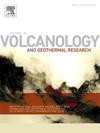断层相交相关的应力旋转控制了内华达斯Chillán火山复合体的岩浆侵位
IF 2.4
3区 地球科学
Q2 GEOSCIENCES, MULTIDISCIPLINARY
Journal of Volcanology and Geothermal Research
Pub Date : 2025-02-01
DOI:10.1016/j.jvolgeores.2024.108255
引用次数: 0
摘要
有人认为,断裂和断层交汇处通过形成渗透性增加的区域,促进了流体在脆性地壳中的输送。然而,人们对控制岩浆在断层交汇处喷发的内在机制仍然知之甚少。为了更好地了解岩浆喷发、火山发展和断层交汇之间的关系,我们考察了南安第斯火山带的内瓦多斯德希廉火山群(Nevados de Chillán Volcanic Complex,NChVC,36.8°S)。该复合体被认为位于两组东北-右侧横向走向滑动断层和一个地震活跃的区域规模西北向继承构造(也被解释为区域断层带)的交汇处。我们利用三维数字图像关联技术,通过无人机(UAV)拍摄的图像,从代表性露头采集了火山尺度上数十条堤坝和数千条断裂的走向和频率数据。我们利用这些数据生成了一个概念模型,说明了不同断裂组对区域荷载的响应以及岩浆喷发的潜在后果。在我们的概念模型中,N-S 至 NW-SE 向断裂会因断层交汇相关的局部应力场旋转而重新活化。这反过来又有利于西北-东南走向的岩浆喷发和西北-东南走向火山的演化。我们的研究结果为旋转岩浆喷发途径提供了力学解释,而这种喷发途径并不一定需要大地壳解锁所带来的瞬时应力状态。本文章由计算机程序翻译,如有差异,请以英文原文为准。
Fault intersection-related stress rotation controls magma emplacement at the Nevados de Chillán Volcanic Complex
It has been suggested that fracture and fault intersections promote enhanced transport of fluids in the brittle crust by forming zones of increased permeability. However, the underlying mechanisms that control the emplacement of magma at fault intersections remain poorly understood. To better understand the relation between magma emplacement, volcano development and fault zone intersections, we examine the Nevados de Chillán Volcanic Complex (NChVC, 36.8°S) in the Southern Andean Volcanic Zone. The complex is thought to be located atop the intersection between two sets of NE-right lateral strike-slip faults and a seismically active regional scale NW-oriented inherited structure, also interpreted as a regional fault zone. We collected data on the orientation and frequency of tens of dykes and thousands of fractures, at the volcano scale, from representative outcrops using three-dimensional digital image correlation techniques, with images taken from Unmanned Aerial Vehicles (UAVs). We use these data to generate a conceptual model of the response of the different fracture sets to regional loads and the potential consequence in terms of magma emplacement. In our conceptual model, N-S to NW-SE striking fractures become reactivated by fault intersection-related local stress field rotations. This, in turn, favors NW-SE aligned magma emplacement, and the evolution of NW-SE aligned volcanoes. Our findings provide a mechanical explanation for rotated magma emplacement pathways, which do not necessarily require a transient stress state imposed by unlocking the megathrust.
求助全文
通过发布文献求助,成功后即可免费获取论文全文。
去求助
来源期刊
CiteScore
5.90
自引率
13.80%
发文量
183
审稿时长
19.7 weeks
期刊介绍:
An international research journal with focus on volcanic and geothermal processes and their impact on the environment and society.
Submission of papers covering the following aspects of volcanology and geothermal research are encouraged:
(1) Geological aspects of volcanic systems: volcano stratigraphy, structure and tectonic influence; eruptive history; evolution of volcanic landforms; eruption style and progress; dispersal patterns of lava and ash; analysis of real-time eruption observations.
(2) Geochemical and petrological aspects of volcanic rocks: magma genesis and evolution; crystallization; volatile compositions, solubility, and degassing; volcanic petrography and textural analysis.
(3) Hydrology, geochemistry and measurement of volcanic and hydrothermal fluids: volcanic gas emissions; fumaroles and springs; crater lakes; hydrothermal mineralization.
(4) Geophysical aspects of volcanic systems: physical properties of volcanic rocks and magmas; heat flow studies; volcano seismology, geodesy and remote sensing.
(5) Computational modeling and experimental simulation of magmatic and hydrothermal processes: eruption dynamics; magma transport and storage; plume dynamics and ash dispersal; lava flow dynamics; hydrothermal fluid flow; thermodynamics of aqueous fluids and melts.
(6) Volcano hazard and risk research: hazard zonation methodology, development of forecasting tools; assessment techniques for vulnerability and impact.

 求助内容:
求助内容: 应助结果提醒方式:
应助结果提醒方式:


